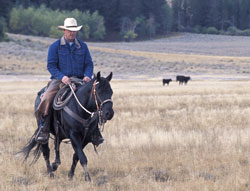
Photo by Edwin Remsberg
The American West evokes images of vast vistas, unyielding independence and quiet authority, a region that is at once easy to define and hard to comprehend. Within this awesome world of grass and sagebrush, which comprises 80 percent of the area from the Great Plains to the Pacific Ocean, a new kind of landowner is emerging to apply practical principles to generate profits while renewing the range.
People like Nevada rancher Agee Smith have worked hard to better understand the complexity of the range so they can coax a living from the land while leaving the delicate landscape in better shape after they’re gone.
“I didn’t know the land at all,” Smith recalls. “I’d never got down on my knees to look. When I did, I saw insects, different plants, the soil. Everything is interconnected, and there’s a reaction for every action you take in this interconnected chain.”
When his 35,000-acre ranch near Elko was being squeezed by economics and environmental regulations, Smith re-tooled. He began focusing more on his land base than his herd size.
Now, Smith takes what he’s learned and demonstrates some of his key strategies to agricultural educators. Smith hosts numerous training events at his ranch, some of them sponsored by the Sustainable Agriculture Research and Education (SARE) program, and involves a multi-disciplinary team in overall ranch management.
“Research provides the pieces to the puzzle,” he says. “I don’t know what the puzzle will look like when it is finished, but my job as an operator is to take all the pieces and put them together as a whole.”
Still, Smith faces the same fundamental limiting factor confronting all business people: environmentally sound management must pay for itself. So the Smith family and others recommend the following strategies to create a truly sustainable range management program:
- Set clear goals
- Understand the plants and their needs
- Graze with various livestock species
- Monitor the vegetation
- Protect soil and water
- Work with other experts
Farmers and ranchers across the American range are testing and adapting forms of the Smiths’ model on their landscapes. Much of that experimentation has been spearheaded by SARE-funded research into range management techniques that pay long-term benefits to people, their land and their communities. This bulletin from the Sustainable Agriculture Network outlines some of that research and recommends strategies that may work on your farm or ranch. See the end of each section and Resources for a list of more in-depth materials.
